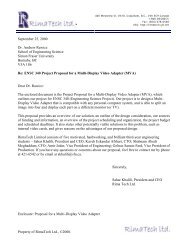Fleksibilni Internet servisi na bazi kontrole kašnjenja i
Fleksibilni Internet servisi na bazi kontrole kašnjenja i
Fleksibilni Internet servisi na bazi kontrole kašnjenja i
You also want an ePaper? Increase the reach of your titles
YUMPU automatically turns print PDFs into web optimized ePapers that Google loves.
Fig. 1. Traffic control mechanisms employed in a QoS capable router.<br />
Admission control implements a decision algorithm that a router employs to<br />
determine whether an incoming request for service can be accepted without disrupting the<br />
service guarantees to established data flows. Unlike in a best-effort network, where a new<br />
connection request is accepted from any source anytime, a Call Admission Control<br />
(CAC) algorithm is executed in a QoS-e<strong>na</strong>bled network. It decides whether to accept or<br />
reject a new connection. The CAC algorithm estimates whether the available resources<br />
meet the set of QoS parameters requested by the connection [32].<br />
Traffic policing ensures that an accepted connection conforms to the QoS<br />
parameters negotiated during the admission control phase. For each packet entering the<br />
network, the policing mechanism detects whether it conforms to the “QoS contract”. If<br />
conforming, the packet is admitted to the router. Otherwise, the policing mechanism can<br />
either drop the packet or decide to accept it as a lower priority packet that will be dropped<br />
if congestion occurs. Policing is necessary only in access routers. There is no need to<br />
police the traffic in core routers [33].<br />
Traffic shaping is used to smooth out packets bursts in cases when incoming<br />
traffic does not conform to negotiated “QoS contract”. Unlike policing mechanisms,<br />
7






